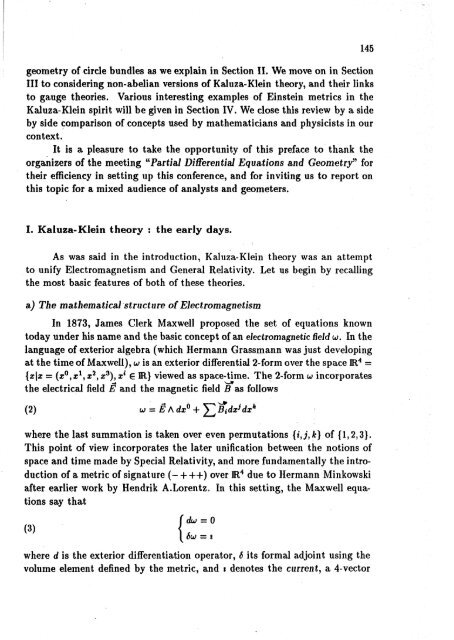Jean-Pierre Bourguignon A MATHEMATICIAN'S VISIT TO KALUZA ...
Jean-Pierre Bourguignon A MATHEMATICIAN'S VISIT TO KALUZA ...
Jean-Pierre Bourguignon A MATHEMATICIAN'S VISIT TO KALUZA ...
Create successful ePaper yourself
Turn your PDF publications into a flip-book with our unique Google optimized e-Paper software.
geometry of circle bundles as we explain in Section II. We move on in SectionIII to considering non-abelian versions of Kaluza-Klein theory, and their linksto gauge theories. Various interesting examples of Einstein metrics in theKaluza-Klein spirit will be given in Section IV. We dose this review by a sideby side comparison of concepts used by mathematicians and physicists in ourcontext.It is a pleasure to take the opportunity of this preface to thank theorgani zers of the meeting "Parfcia/ Differentìal Equations and Geometry" fortheir efficiency in setting up this conference, and for inviting us to report onthis topic for a mixed audience of analysts and geometers.145I. Kaluza-Klein theory : the early days.As was said in the introduction, Kaluza-Klein theory was an attemptto unify Electromagnetism and General Relativity. Let us begin by recallingthe most basic features of both of these theories.a) The mathematica! structure of ElectromagnetismIn 1873, James Clerk Maxwell proposed the set of equations knowntoday under his name and the basic concept of an ekctromagnetic fìeldu>. In thelanguage of exterior algebra (which Hermann Grassmann was just developingat the time of Maxwell), u; is an exterior differential 2-form over the space IR 4 ={x\x = (x° 1 x l i x 2 , a; 3 ), x* e IR} viewed as space-time. The 2-form w incorporatesthe electrical fìeld E and the magnetic fìeld B as follows(2) w = È A dx b + Y^ B^idx j dx kwhere the last summation is taken over even permutations {ij f k} of {1,2,3}.This point of view incorporates the later unification between the notions ofspace and time made by Special Relativity, and more fundamentally the introductionof a metric of signature (- + ++) over IR 4 due to Hermann Minkowskiafter earlier work by Hendrik A.Lorentz. In this setting, the Maxwell equationssay that{du = 0Su = iwhere d is the exterior differentiation operator, 6 its formai adjoint using thevolume element defined by the metric, and i denotes the current, a 4-vector














